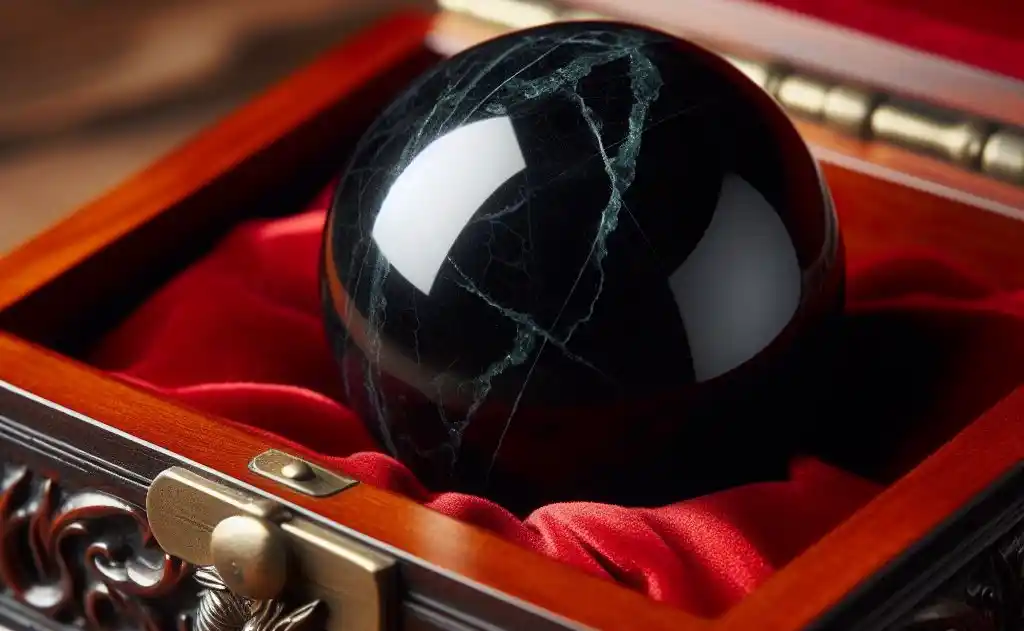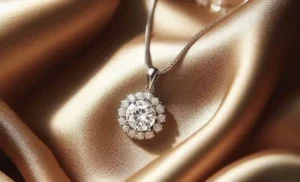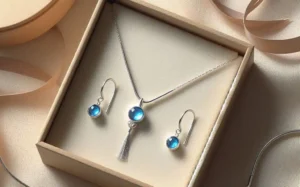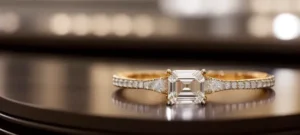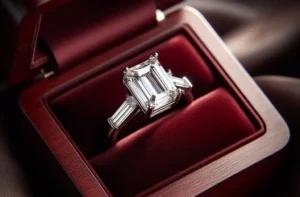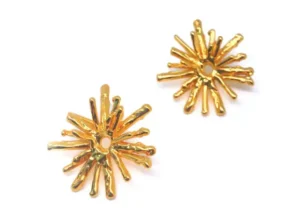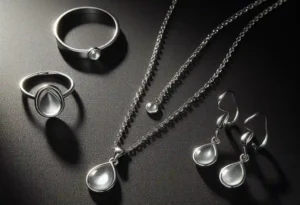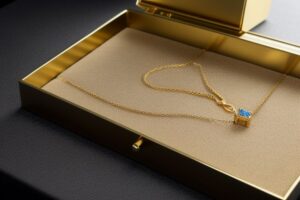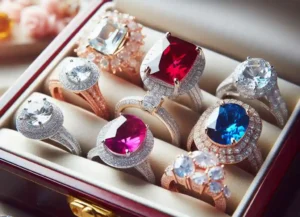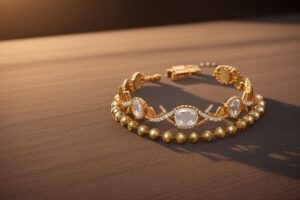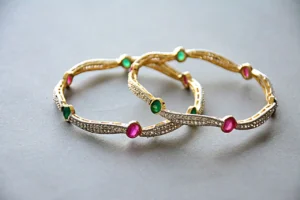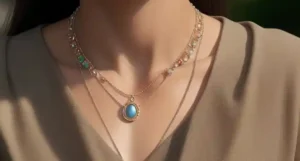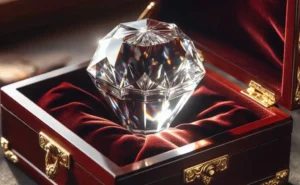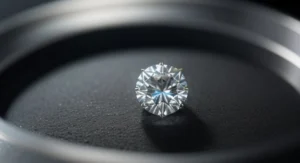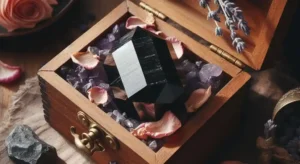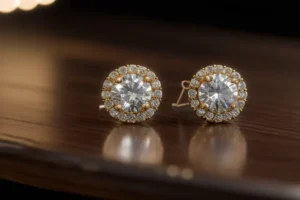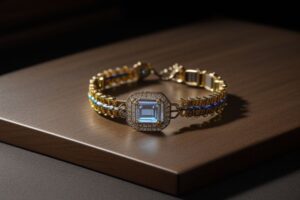Black obsidian is a beautiful and mysterious gemstone that has been used for centuries for its powerful healing properties.
However, with the rise of counterfeit gemstones in the market, it has become increasingly important to know how to identify the authenticity of black obsidian.
In this blog post, we will explore the key characteristics and tests to determine whether your black obsidian is real or fake, so you can confidently incorporate this stunning gemstone into your collection.
How to Tell if Black Obsidian is Real?

Determining the authenticity of black obsidian involves a multi-faceted approach that emphasizes both its physical and aesthetic properties. Here are key points to consider:
– Visual Inspection: Look for the glass-like luster and deep black color characteristic of genuine black obsidian. Authentic pieces may also display minor natural imperfections, such as tiny air bubbles or slight inclusions.
– Water Test: Submerge the obsidian in water to better observe surface details. Real obsidian will have subtle irregularities and a faint ripple texture, evidencing its volcanic glass origins.
– Scratch Test: Use an object of known hardness to gently scratch the stone’s surface. Genuine obsidian, being a form of natural glass, should resist scratching under moderate pressure.
– Weight and Temperature Assessment: Feel for the stone’s heft and its cool temperature upon initial touch. Authentic black obsidian has a noticeable weight and remains cool longer due to its dense composition.
– Sound Test: Gently tap the stone with a metal object and listen for a clear, high-pitched ring. This sound is indicative of the conchoidal fractures typical of real obsidian.
These methods provide a comprehensive toolkit for verifying the authenticity of black obsidian without requiring specialized equipment.
Understanding the Basics of Black Obsidian
Black obsidian, a captivating form of volcanic glass, originates from the rapid cooling of felsic lava. This quick transition from a molten state to a solid form is what gives obsidian its glassy texture and prevents the crystallization process, distinguishing it from other types of crystals that form under slower cooling conditions.
Its appearance is striking, predominantly featuring a deep, dark black color that may sometimes include subtle variations or sheens due to the presence of mineral impurities. These impurities can introduce a range of visual effects, including a silvery or rainbow sheen, which are highly prized among collectors.
The formation of black obsidian is typically associated with the peripheries of volcanic domes and the edges of volcanic flows, where the rapid cooling process occurs. Its natural occurrence in areas of historical or recent volcanic activity highlights its deep connection to the Earth’s dynamic processes.
The distinctive characteristics of black obsidian, from its deep coloration to its glass-like luster, make it a sought-after material in jewelry making, decorative objects, and various healing and spiritual practices.
Understanding these fundamental aspects of black obsidian is crucial for enthusiasts and collectors to appreciate its natural beauty and the conditions under which it forms.
The Visual Inspection Test
The Visual Inspection Test relies on a discerning observation to differentiate genuine black obsidian from its counterfeit counterparts. This technique emphasizes the unique characteristics that are inherent to obsidian due to its volcanic glass nature.
When conducting this test, focus on identifying the hallmark glossy finish of obsidian, which should be evident even at a glance. However, the key to authenticity lies in the details. Genuine obsidian may reveal minor imperfections upon close inspection—tiny air bubbles or minuscule inclusions that testify to its natural formation process.
These subtle flaws are essential clues, as they are rarely replicated with precision in synthetic versions. Fake obsidian pieces often either exaggerate the glossiness, attempting to appeal to the untrained eye, or lack the finesse to include such natural imperfections, resulting in a too-perfect appearance that hints at artificial manufacture.
This method of visual inspection does not merely judge the stone by its reflective qualities but delves deeper into the intrinsic properties that define real black obsidian, distinguishing it from mere imitations that lack its volcanic essence and natural beauty.
The Water Test for Surface Imperfections
The Water Test serves as a simple yet insightful method to uncover the intricate details of black obsidian that might go unnoticed under regular conditions. By submerging the stone in clear water, you effectively enhance your ability to scrutinize the surface for authenticating features.
This immersion technique works because water acts as a magnifier, revealing the stone’s texture and any minor imperfections or unique characteristics inherent to natural obsidian. In the case of genuine black obsidian, expect to observe slight irregularities or a faint ripple texture, subtle nods to its volcanic glass origins.
These features are difficult to replicate accurately in synthetic materials, which often present an overly consistent and flawless appearance. Conversely, artificial stones might display uniformity in texture that lacks the nuanced variations found in true obsidian.
This test hinges on the principle that natural formations, unlike man-made counterparts, carry with them the imperfections of their creation process. By employing the Water Test, one can delve beyond the superficial qualities of the stone, gaining insights into its true nature without causing any harm or alteration to the specimen under examination.
Conducting the Scratch Test
The Scratch Test offers a practical approach to assessing the durability and, consequently, the authenticity of black obsidian. This method leverages the stone’s inherent hardness, characteristic of its natural, volcanic glass composition.
To conduct this test, utilize a tool of known hardness, such as a piece of common glass or a metal object. Carefully attempt to make a scratch on the surface of the stone. True black obsidian, owing to its hard and resilient nature, should resist scratching under moderate pressure.
It’s essential, however, to approach this test with a delicate hand to prevent any unnecessary damage to the stone, especially if it’s a valued piece of your collection. The key here is not to leave a noticeable mark but to observe the stone’s reaction to the attempted scratch.
Fake materials masquerading as black obsidian, such as plastic or softer types of glass, will likely succumb to scratching more easily, revealing their lesser hardness and authenticity. This evaluation of the stone’s resistance to scratching can be a telling sign of its genuineness, provided it’s performed with care and consideration for the specimen’s preservation.
Assessing the Weight and Temperature
One definitive way to gauge the authenticity of black obsidian is through its distinct physical properties, particularly its weight and temperature. Genuine black obsidian possesses a unique density that contributes to a noticeable weightiness when held, a characteristic that distinguishes it from common counterfeit materials like plastic or resin, which might mimic its appearance but not its heft.
This significant weight is a direct reflection of its origin as a type of volcanic glass, formed under the intense conditions of rapidly cooling lava.
In addition to its weight, the temperature of black obsidian provides another clue to its authenticity. Due to its dense composition, authentic obsidian naturally maintains a cool temperature, a feature that is particularly discernible when first picked up.
This coolness is not merely an initial observation; real obsidian retains this lower temperature for a considerably longer period compared to artificial substitutes. Even in a warmer environment, it demonstrates a remarkable ability to remain cool to the touch, gradually adjusting its temperature in response to prolonged contact with the skin.
This thermal characteristic is not just a superficial trait but a tangible link to its geological roots, offering both a literal and metaphorical coolness that synthetic imitations cannot replicate.
By closely examining these aspects, collectors and enthusiasts can further ensure the authenticity of their black obsidian specimens, appreciating not just their aesthetic value but their inherent natural properties.
The Sound Test: Listening for Authenticity
The Sound Test offers an intriguing way to examine black obsidian, utilizing the sense of hearing to discern its genuineness. This unconventional method involves lightly tapping the stone with a metal object, such as a coin or a spoon.
Authentic black obsidian, due to its glass-like composition and structure, will emit a clear, resonant ring that is distinctively high-pitched. This unique acoustic signature stems from its conchoidal fractures—sharp breaks that occur in a curved manner, similar to the way glass shatters.
These fractures allow the sound waves to propagate in a specific pattern, producing the characteristic ringing sound. In contrast, counterfeit materials or other types of glass and stones might produce a duller, thudding sound when subjected to the same test.
The clarity and pitch of the sound produced can offer valuable insights into the material’s composition, providing an auditory clue to its authenticity. It’s important to conduct this test in a quiet environment to accurately assess the sound qualities and to ensure that the tapping is gentle to avoid damaging the obsidian.
This method, while less commonly known, adds an additional layer of verification to the multifaceted approach of authenticating black obsidian, making it a useful tool in the arsenal of any collector or enthusiast seeking to confirm the genuine nature of their specimen.
Professional Verification: When in Doubt
For those instances where the authenticity of black obsidian remains ambiguous despite employing various self-tests, seeking the expertise of a professional gemologist becomes imperative. These specialists are equipped with advanced tools and possess the nuanced knowledge required to definitively ascertain the genuineness of the stone.
Techniques such as spectroscopy delve into the material’s chemical composition, offering irrefutable proof of its natural origins, while microscopic analysis can uncover telltale signs invisible to the naked eye, such as specific inclusions or textures unique to true volcanic glass.
This level of examination goes far beyond the capacity of lay methods, providing a level of certainty that can be crucial for collectors and enthusiasts who wish to ensure the integrity of their acquisitions.
Engaging with a certified gemologist not only affirms the authenticity of the stone but also enriches one’s understanding of its characteristics, origins, and value. It is a step that underscores the commitment to maintaining a collection of genuine significance and preserving the historical and geological narrative encapsulated within each piece of black obsidian.
Common Pitfalls to Avoid When Shopping
Navigating the marketplace for genuine black obsidian can be fraught with challenges. A critical mistake many make is succumbing to the allure of bargain prices. Authentic black obsidian, with its rich, volcanic essence and captivating sheen, commands a fair market value.
Beware of offerings that significantly undercut this, as it often signals subpar or counterfeit products. Another common pitfall is not vetting the seller’s credibility. It’s crucial to engage with vendors who have a transparent track record, providing clear details about the provenance and properties of their obsidian.
Avoid those who resort to ambiguous or overly generic descriptions of the stone’s authenticity, as this lack of specificity can be a red flag for deception.

